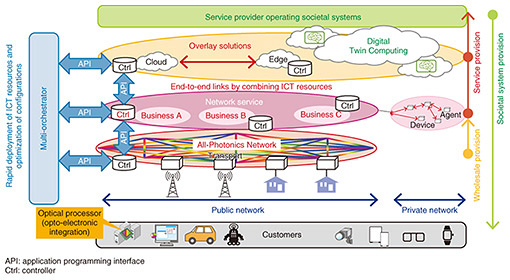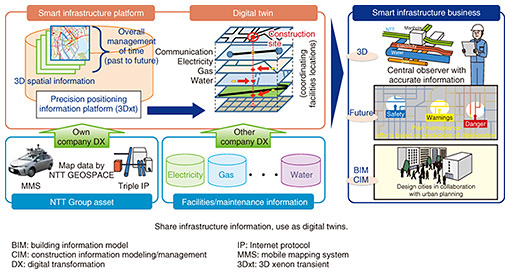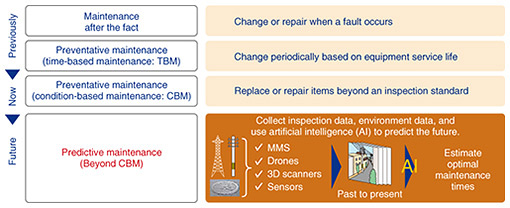 |
|
|
|
|
|
Feature Articles: Keynote Speeches/Workshop Lectures at Tsukuba Forum 2019 Vol. 18, No. 4, pp. 27–34, Apr. 2020. https://doi.org/10.53829/ntr202004fa5  Working toward Sharing Social InfrastructureAbstractThis article introduces initiatives for sharing the social infrastructure within the NTT Group, including concrete measures to resolve societal issues and other initiatives. It was prepared based on a keynote speech given by NTT Senior Executive Vice President Motoyuki Ii at the Tsukuba Forum 2019 held on October 31 and November 1, 2019. Keywords: sharing of social infrastructure, smart infrastructure, smart energy 1. IntroductionAs human economic development has progressed, the burden on the environment has continued to increase. With advances in information and communication technology (ICT), increasing amounts of energy and resources are being consumed. The NTT Group has an obligation to work actively on reducing this burden on the environment while also contributing to economic development (Fig. 1). Three key points in this area are that (1) the NTT Group overall must change its mindset; (2) the NTT Group must show these changes by concrete action; and (3) technical innovation will support this action. These three points form the basis for this lecture.
The main economic model has been linear economy, in which products are made from materials, sold and used, then discarded. Taking automobiles as an example, the number of cars has increased as the economy brought prosperity, going from one car per household to one car per person. As a result, we are using more materials and energy, building more roads, and continuously increasing the load on the environment. The same applies to home appliances. As people have become richer, households have air-conditioners and several televisions. The situation is the same in our field, i.e., ICT. As ICT becomes more abundant, the amount of information being circulated increases, and the amount of energy needed increases. Such activity is definitely not environmentally friendly. However, life is more convenient, and society is safer and more secure. So what approaches are there to reducing the burden on the environment? 1.1 Circular economyThe idea of the circular economy is now considered obvious in Europe, particularly in the Netherlands. This is a recycling-based economic system; re-using items or returning them to usable base materials. If that is not possible, then burning them to produce energy. We need to adopt technology to reduce the load on the environment and develop the economy by providing things as services and not owning them, or sharing them and not having exclusive ownership. Companies and private citizens will need to work toward a circular economy, sharing rather than owning assets, and using as many renewable sources of energy as possible (Fig. 2).
1.2 Peer-to-Peer (P2P) sharing economyThe P2P sharing economy is being advanced mainly by individuals. More people register to provide services in various categories, and users can use these services without owning anything. Such an economy has begun in many sectors of society, and re-using things and using renewable resources are advancing. The background to this sharing economy is, of course, sharing rather than owning. A value is emerging that it is better to share with everyone because it is a waste to throw things away, and an economy is emerging in which buyers and sellers can trade one-to-one, immediately and every day. However, in the prevalent model in the field of communications, facilities, such as antennas, conduits, and power supplies, are equated with services, which has led providers to exclusively own facilities. In the mobile communications field, the ability to install antennas in good locations is an advantage for companies, so there is a tendency for companies to install them in similar locations. We argue that competition regarding facilities and services are the same, but this has increased the burden on the environment. We will need to change this approach by separating facilities and services, sharing as many facilities as possible, and competing in terms of services (Fig. 3).
1.3 Sharing social infrastructure in ICTWhat does the social infrastructure mean in ICT? A social infrastructure is defined to include facilities such as antennas, conduits, and power supplies for telecommunication companies. Physical equipment, such as computers, servers, and storage, and even data in cloud technology are included. To share these assets, they must be created and used jointly, or made open and used in a reciprocal manner. Therefore, so-called infrastructure sharing must be considered to include the use of data (Fig. 4). If our efforts thus far have been egocentric, our mindset needs to be changed to be eco-centric, moving from a linear economy to a circular economy, and from owning to sharing at the business level.
2. Concrete initiatives at NTTThe NTT Group has qualities of both a public and private organization, and is required to bear some responsibility toward society as a whole. To find solutions for various issues in society through our business activities, we need to collaborate with partners. As a result, we are oriented toward forming a smart world, or Society 5.0, as it is being called in Japan, and to contribute to the United Nations’ Sustainable Development Goals (SDGs). Below we introduce our three businesses working toward such collaboration: Mobile Communications, Smart Infrastructure, and Smart Energy. 2.1 Mobile Communications businessSocial issues in this business are reducing the capital cost of facilities, accelerating infrastructure building for national deployment of fifth-generation mobile communication systems (5G), and securing space to build 5G base stations. Our theme is, “Do we really still need to compete in terms of facilities in these areas?” Would it not be better to share as much infrastructure as possible, reduce costs, and use space, which is a societal resource, more effectively? (1) Building sharing (indoor/outdoor) JTOWER is a company that is neutral with respect to mobile carriers, and is working to build antennas collaboratively. As a pure holding company, NTT has investment and business ties with JTOWER. This is the first step. We would like to expand the sharing model and overcome barriers among mobile carriers in the 5G era. As 5G is introduced into buildings, factories, and other workplaces, construction of many antennas in buildings will be necessary. If every company does this, the number of antennas, cabling, power supplies, and other facilities will be unwieldy. This has led to initiatives toward in-building system (IBS) sharing to simplify and share antennas and other facilities, at least within buildings. This would help reduce costs and energy consumption. There will be a need for neutral companies to carry such efforts into the future. In particular, JTOWER is working with tenants, shopping malls, and other commercial buildings on IBS sharing. Since companies are building their own separate antennas, integration of these facilities is necessary. There is also increasing need to build 5G antennas outside (towers). Density is lower in rural areas, so 5G business would not be profitable, while sharing business will have great financial significance. In urban areas, there is little space for building facilities, so it makes sense to share the small available space. Even if JTOWER does not build all facilities, it would be beneficial for carriers to open access to their own towers and other facilities. When 5G frequencies were first allocated, the Ministry of Internal Affairs and Communications (MIC) divided Japan into a mesh of approximately 4500 10-km2 sections. Each carrier was asked what percentage of these sections they would cover by 2024, and the requested frequency allocations were granted giving priority to carriers that declared to provide 5G services covering more of these sections. Four carriers overlapped in most of these approximately 4500 sections, so we believe that it will be an issue whether these carriers will have separate facilities or share facilities. Each company is also currently building their own mobile front-haul (MFH), which connects base stations to each of their antennas, and mobile back-haul (MBH), which connects base stations and base stations to their core communications networks. We would like to share these facilities in the future. However, for the MFH, dark fiber is used to send radio-frequency signals between base stations and antennas. If technical innovation produces a low-latency transmission scheme, it will be possible to overcome constraints on distances to base stations and bring signals to neighboring buildings. This will allow base-station equipment to be installed in various buildings, contributing to sharing buildings and using them more effectively. If such networks can be given loop topology, redundancy will also increase. As building resources are limited, it will be necessary to promote building sharing by sharing and introducing new technologies, which requires technical innovation (Fig. 5).
(2) Promoting interoperability of base-station equipment The Open Radio Access Network (O-RAN) Alliance is an industry consortium gathering carriers and vendors from around the world. Until now, vendors have built base-station equipment using their own interfaces, creating an environment in which products of a company can only be connected with each other. This has made sharing difficult, so the O-RAN Alliance is defining open interfaces. For the next stage, Advanced 5G, if vendors make their products based on open interfaces, a testbed will be prepared to check these interfaces and interconnectivity and interoperability can be checked with each product, there will be an environment in which products from different vendors can co-exist. This kind of initiative will contribute to sharing. (3) Vision for networks in the future A three-layer model (Fig. 6) describes network issues. The bottom layer is the transport layer, consisting of communication media such as fiber or wireless. The middle layer is the network-service layer, provided by each carrier providing various services to customers. The top layer contains overlay solutions, creating various services using the cloud. For example, services created by GAFA (Google, Apple, Facebook, and Amazon) are at this layer. Actual services are provided by combining network resources with overlay-solution resources using multi-orchestration. Note that “sharing,” as we mentioned so far, applies to the most basic transport layer, including antennas and transmission channels. However, service competition will occur in the top overlay-solution layer. We can provide new value to users by combining sharing and competition.
2.2 Smart Infrastructure businessBy infrastructure, we refer to underground facilities such as conduits and cable tunnels, and the related data. The underground facilities of service providers, such as those for gas, water, and electricity, as well as communication, have become very old. Personnel who build and maintain such facilities are also getting older, and facilities are managed separately by each company. This is inefficient and places an extra burden on the environment. Such conditions have led to the idea of smart infrastructure, in which companies can share data and find various efficiencies that can reduce the burden on the environment, even if they do not share all their facilities. To achieve this, it will be necessary to layer databases of the facilities held by each company on a single map. Companies do not know what facilities others have or what is buried at a certain depth. They each carry out work, such as digging up roadways, at different times. The first requirement is therefore to share the data. The data must be opened, and all facilities must be made visible based on this open data. A platform to accomplish this is needed. When real facilities are converted to digital data and used to layer the digital world over the real, it is called a digital twin. The success of this effort will depend on the quality of digital twin creation to reveal how the facilities are deployed underground. This will require three-dimensional (3D) technology, prediction technology, and so on. Achieving such a system will enable companies to coordinate to build and maintain underground facilities, rather than doing it separately as they have been (Fig. 7). For example, when repairing a road, a database will enable the repair work to be observed centrally by representatives from a different company. Currently, an initiative is being promoted called i-Construction, in which excavation equipment is operated based on data regarding objects buried at the site. Assuming the data are correct, this will help avoid incidents such as accidental cutting of service lines. We expect that the time is coming when it will be standard to simulate work in cyberspace before working in the real world.
Maintenance has been conducted by replacing components based on fault criteria such as inspections or years of service life. By digitizing facility information, prediction technologies can be used to predict what will occur based on the data, potentially reducing the need for inspections (Fig. 8). We feel that if companies having a societal infrastructure, such as communications cables, gas and water lines, or electrical conduits, are able to conduct work on them efficiently by coordinating with each other in some way, it would lessen environmental burden. To achieve this, NTT changed the ownership of NTT InfraNet from NTT EAST to our holding company, changed the management structure, and increased capitalization to conduct a smart maintenance business and build a database, as described above, for the NTT Group and for other companies. This was our first initiative. When building smart cities, operators and the types of pipes and wiring will be decided in the design stages, and it will be possible to examine entire urban areas in cyberspace, including aspects such as scenery.
2.3 Smart Energy businessCommunications and energy are inextricably linked. We feel a great responsibility as a communications operator and have been developing ICT rapidly and are continuing to build datacenters, thus dramatically increasing energy consumption. We have our own initiatives to reduce the burden on the environment by supporting efforts to shift from using fossil fuels to renewable energy sources. There have also been repeated large-scale disasters recently, which have damaged communications and other societal infrastructures worldwide. Providing emergency power supplies at such times is becoming an important issue. To find solutions to such societal issues, we have created a new subsidiary called NTT Anode Energy Corporation to share NTT’s communications infrastructure and buildings (central offices) and contribute to building a sustainable society. Currently, only 16% of the energy used in Japan is renewable, and even for 2030 targets, we have given only relatively passive figures of 22 to 24%. There are countries in Europe achieving this in the 30% range, and some are declaring that they will increase this rate to over 40%. It will be difficult to achieve 100% renewable energy, but increasing this amount is necessary. However, renewable energy has its weaknesses compared with fossil fuel or nuclear power generation. For example, the amount of power generated from solar power fluctuates greatly depending on the weather. Wind power is similarly unstable, varying with the strength of the wind. There are also issues with supply and demand. Urban areas have very high demand for electrical power, but rural areas have environments that can actually supply renewable energy, while themselves consuming less electricity. This balance of supply and demand has not been achieved, and connecting everything with power lines would be costly, even for just transmission and distribution lines. A mechanism to maximize the utilization of renewable energy is needed. One solution is distributed energy. The supply-and-demand balance issue can be resolved to a certain extent by consuming the energy near where it is generated. In many regions, renewable energy has been introduced as a backup for alternating current (AC) power, but when there is sufficient AC power available, this produces excess supply, so power generation is stopped. It would be good if the excess could be stored in batteries and used when needed. However, such initiatives are not currently being undertaken, and in reality, all the renewable energy that could be generated is not being used. We will need to somehow overlay the renewable-energy distributed-energy system on the existing AC power system and maximize utilization of renewable energy. Some possibilities in such situations include placing batteries in the many buildings owned by NTT or possibly building DC (direct current) transmission and distribution networks though the conduits that we also have between buildings. Communication operators are also well situated to show expertise in controlling and managing the energy network. ICT technology will be needed for controlling supply and demand such as electricity discharge/generation management and visualization. This will need to be automated and autonomized with artificial intelligence, using appropriate triggers. 3. ConclusionThe NTT Group will continue in its efforts toward a sustainable environment, and we hope everyone involved will support and collaborate with us in these efforts. |
|
















